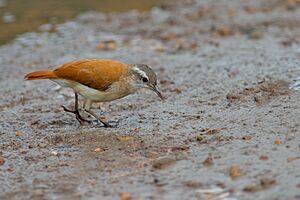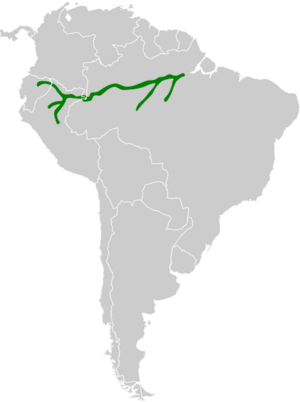Lesser hornero facts for kids
Quick facts for kids Lesser hornero |
|
|---|---|
 |
|
| Conservation status | |
| Scientific classification | |
| Genus: |
Furnarius
|
| Species: |
minor
|
 |
|
The lesser hornero (scientific name: Furnarius minor) is a small bird that belongs to the Furnariidae family. This family is also known as the "ovenbirds" because of their unique nests. The lesser hornero is a special bird because it is monotypic. This means it doesn't have different types or subspecies, unlike many other birds.
Contents
Where Do Lesser Horneros Live?
The lesser hornero lives in parts of South America. You can find them in Brazil, Colombia, Ecuador, and Peru. They live mostly along the banks of the mighty Amazon River and its large branches.
What Kind of Home Do They Like?
These birds are river specialists. This means they love living near rivers! They prefer areas with young trees and bushes right by the water's edge. They also like new islands that form in the rivers. In Peru, they sometimes live in the lower parts of Cecropia forests.
This special type of home depends on seasonal floods. Flooding helps create the perfect patchy habitat they need. They live at low elevations, usually from about 50 to 200 meters (164 to 656 feet) above sea level.
What Does a Lesser Hornero Look Like?
The lesser hornero is a very small ovenbird. It is about 12 to 13 centimeters (4.7 to 5.1 inches) long. It weighs around 23 to 29 grams (0.8 to 1 ounce), which is about the weight of a few coins!
Distinctive Features
- Head: Its head is grey. It has a clear white stripe right above its eye.
- Throat: The throat is white.
- Body: Its lower back (rump) and wings are a reddish-brown color. The chest and sides are a light brownish-yellow, becoming even paler underneath.
- Bill: It has a long, straight beak.
- Gender Differences: Both male and female lesser horneros look the same.
- Young Birds: Scientists haven't described what young lesser horneros look like yet.
What Do Lesser Horneros Eat?
Lesser horneros mainly eat small creatures like arthropods and other invertebrates. These are tiny animals without backbones, like insects and worms.
They hunt alone or in pairs. They search for food on the ground, in the mud along the river banks, or on low branches. They often look for prey in thick bushes and plants.
Lesser Hornero Reproduction and Nesting
Like other birds in the Furnarius family, the lesser hornero builds a unique nest. They make a mud "oven" nest in the branches of trees.
Building Their Mud Oven Nest
The nest looks like a small clay oven, which is why they are called ovenbirds! They line the inside of this mud nest with soft materials like grasses and animal hair.
Eggs and Young
A female lesser hornero usually lays four eggs. Not much more is known about their nesting habits. However, they have been seen building nests in November and incubating their eggs in January.


